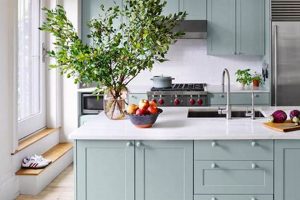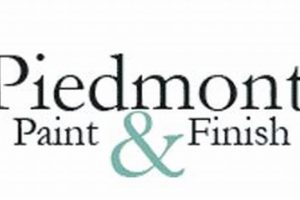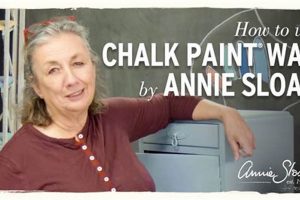This particular wall coating option presents a low-luster sheen, falling between matte and satin finishes. It is often selected for its subtle reflectivity, which helps to minimize the appearance of imperfections on surfaces. As an example, a room painted with this coating will exhibit a soft, muted glow without the high gloss of a shinier alternative.
The selection of this type of coating is driven by a combination of aesthetic and practical considerations. Its subtle sheen offers a degree of durability and washability greater than matte options, making it suitable for areas that experience moderate traffic and require occasional cleaning. Historically, its understated elegance has made it a popular choice for both residential and commercial interiors.
Subsequent sections will explore its application techniques, ideal use cases within various rooms, and comparisons with other available coating options, thereby providing a complete understanding of its characteristics and suitability for diverse projects.
Essential Application Guidelines
The following guidelines offer insights to achieve optimal results when utilizing this wall coating solution.
Tip 1: Surface Preparation is Paramount: Ensure surfaces are clean, dry, and free of loose debris. Priming is advisable, especially over previously painted walls or bare drywall, to promote adhesion and color uniformity.
Tip 2: Utilize Quality Application Tools: Employ high-quality brushes and rollers suitable for latex coatings. This ensures even coverage and minimizes brush or roller marks on the finished surface.
Tip 3: Apply Thin, Even Coats: Avoid applying excessive amounts of coating in a single pass. Multiple thin coats are preferable, allowing each layer to dry completely before the next application.
Tip 4: Maintain a Wet Edge: When painting large areas, maintain a wet edge to prevent lap marks. Overlap each stroke slightly with the previous stroke while the coating is still wet.
Tip 5: Proper Ventilation is Crucial: Ensure adequate ventilation during and after application to facilitate drying and minimize odor. Open windows or use fans to circulate air.
Tip 6: Adequate Dry Time: Allow sufficient drying time between coats and before putting the room back into service. Consult the manufacturer’s instructions for recommended drying times.
Tip 7: Gentle Cleaning: This coating offers some washability. When cleaning is necessary, use a soft, damp cloth and a mild detergent to avoid damaging the finish.
Adhering to these recommendations will contribute to a professional-looking result, enhancing the longevity and aesthetic appeal of the coated surfaces.
The subsequent article sections will delve into the practical applications and comparisons with other coating options to provide a deeper understanding.
1. Subtle sheen
The defining characteristic of this particular wall finish resides in its subtle sheen, a quality that dictates its suitability for various applications. The level of sheen directly influences the amount of light reflected by the painted surface. In this finish, the low reflectivity minimizes glare and softens the appearance of walls, effectively disguising minor imperfections that might be highlighted by glossier coatings. This is because its surface scatters light rather than reflecting it directly, providing a softer visual texture.
The importance of this subdued reflectivity extends to practical considerations such as room ambiance and light management. For instance, rooms with abundant natural light benefit from its ability to diffuse light without creating harsh reflections, making it comfortable and visually appealing. Consider a living room or bedroom where the absence of a high-gloss surface reduces strain on the eyes, creating a relaxed atmosphere. Similarly, in hallways or entryways, the decreased reflectivity minimizes the visibility of scuffs and fingerprints, contributing to a cleaner appearance. This degree of understated luminosity contributes significantly to its popular use in interiors.
Understanding the nature of this understated sheen enables informed decisions about coating selection for different spaces. Its balance between hiding flaws and providing a modicum of washability makes it a versatile option. Choosing this specific paint finish can introduce practical and aesthetic advantages, ensuring spaces maintain a balance between utility and visual appeal.
2. Durability balance
The characteristic durability afforded by an “eggshell paint finish” represents a mid-point between delicate matte and resilient glossy options. This balance is a critical consideration when selecting a coating, as it influences the longevity and maintenance requirements of the painted surface.
- Resistance to Scuffing and Marking
The “eggshell paint finish” provides a degree of resistance to everyday scuffs and marks that is superior to matte finishes. This stems from its slight sheen, which creates a tighter surface film. For example, a wall painted with this finish in a hallway will withstand incidental contact better than a wall painted with a flatter coating. This improved resistance contributes to reduced cleaning frequency and prolonged aesthetic appeal.
- Cleanability and Washability
While not as easily cleaned as higher-gloss options, the “eggshell paint finish” offers a practical level of washability. Minor stains and dirt can generally be removed with a damp cloth and mild detergent without damaging the coating. This makes it suitable for areas prone to occasional soiling, such as kitchens and bathrooms, where regular cleaning is necessary. The ability to maintain a clean surface without compromising the finish’s integrity is a key advantage.
- Abrasion Resistance
The “eggshell paint finish” resists abrasion better than flat paints. However, it is more susceptible to damage from heavy scrubbing or abrasive cleaners compared to semi-gloss or gloss finishes. Its medium-level protection against abrasion makes it appropriate for walls that receive moderate contact but may not hold up under high-traffic conditions or frequent aggressive cleaning.
- Longevity and Re-coat Frequency
Due to its balanced durability, the “eggshell paint finish” typically requires less frequent re-coating compared to matte finishes. While wear and tear will eventually necessitate repainting, the coating’s resistance to minor damage extends its lifespan. This translates to long-term cost savings and reduced maintenance efforts. The reduced need for frequent touch-ups makes it a practical choice for homeowners and facility managers alike.
These facets of durability highlight why the “eggshell paint finish” represents a viable choice for numerous interior applications. Its blend of aesthetic appeal and moderate resilience makes it a versatile coating option for spaces where both appearance and functionality are important. For instance, in a child’s bedroom, its washability addresses potential messes, while its understated sheen provides a calming backdrop. The judicious selection of this coating can significantly impact the long-term maintenance and visual satisfaction of interior spaces.
3. Washability factor
The “washability factor” is a primary consideration when evaluating the practical attributes of an “eggshell paint finish”. It directly impacts the ease with which surfaces can be maintained and cleaned, influencing the long-term appearance and utility of the coated area.
- Surface Porosity and Stain Resistance
The low-luster surface of an “eggshell paint finish” exhibits a degree of porosity that affects its resistance to stains. While less porous than a matte finish, it is more so than a semi-gloss or gloss coating. This means it offers moderate stain resistance. For instance, water-based spills can typically be wiped away without leaving a permanent mark, whereas oil-based stains might require more aggressive cleaning methods. The balance between porosity and cleanability is crucial for maintaining the coating’s appearance.
- Cleaning Agent Compatibility
The “washability factor” necessitates careful consideration of cleaning agents. Harsh chemicals or abrasive cleaners can damage the “eggshell paint finish,” leading to discoloration or loss of sheen. Mild, non-abrasive detergents diluted in water are generally recommended for cleaning. For example, a gentle wipe with a damp cloth and a pH-neutral cleaner is often sufficient to remove household grime. The compatibility of cleaning products with the coating directly affects its longevity and appearance.
- Abrasion Resistance During Cleaning
The degree of abrasion resistance during cleaning is a key component of the “washability factor.” The “eggshell paint finish” is more susceptible to scratching from vigorous scrubbing compared to higher-gloss coatings. Therefore, gentle cleaning techniques are advised to avoid compromising the finish. For instance, using a soft sponge or microfiber cloth rather than an abrasive pad will help preserve the coating’s integrity. The balance between effective cleaning and preventing damage is essential.
- Impact of Repeated Cleaning
Repeated cleaning can gradually affect the appearance of an “eggshell paint finish” over time. Excessive wiping, even with mild detergents, can slowly erode the coating’s surface, leading to a slight dulling of the sheen. To mitigate this, cleaning should be performed only when necessary and with a gentle touch. This ensures that the coating maintains its aesthetic qualities for an extended period. The durability of the finish under repeated cleaning is a practical consideration for high-traffic areas.
In conclusion, the “washability factor” of an “eggshell paint finish” is a nuanced attribute that balances stain resistance, cleaning agent compatibility, abrasion resistance, and the impact of repeated cleaning. Careful consideration of these factors allows for informed maintenance practices, ensuring the coating retains its appearance and protective qualities over time. The appropriate selection and care of this paint finish can significantly contribute to the long-term aesthetic value of interior spaces.
4. Application specifics
The success of an “eggshell paint finish” is intrinsically linked to adherence to specific application protocols. The inherent characteristics of this coating, such as its viscosity and drying time, necessitate precise techniques to achieve a uniform and visually appealing surface. Deviations from recommended practices directly impact the final outcome, potentially resulting in an uneven sheen, visible brushstrokes, or inadequate adhesion. For example, failure to properly prime a porous surface before applying the “eggshell paint finish” can lead to uneven absorption, resulting in a blotchy appearance and diminished durability. The meticulous execution of each application step is therefore not merely a recommendation but a fundamental requirement for realizing the coating’s intended benefits.
The importance of “application specifics” extends beyond surface preparation and priming to encompass the selection of appropriate tools and techniques. Utilizing high-quality brushes and rollers designed for latex paints is crucial for achieving an even coat and minimizing texture irregularities. Similarly, maintaining a wet edge during application prevents lap marks, ensuring a seamless transition between painted sections. Proper environmental conditions, such as temperature and humidity levels, also play a significant role. Applying the coating in excessively humid conditions can prolong drying time, potentially leading to runs or sags. In contrast, applying it in extremely hot conditions can cause premature drying, resulting in poor adhesion and a rough texture. These practical considerations highlight the need for a comprehensive understanding of application variables to achieve optimal results.
In summary, the “eggshell paint finish” is not simply a product but a system that requires careful attention to detail throughout the application process. Neglecting “application specifics” can compromise the coating’s aesthetic qualities and functional performance. A thorough understanding of surface preparation, tool selection, application techniques, and environmental factors is essential for maximizing the benefits of the “eggshell paint finish” and achieving a durable and visually appealing result. Mastering these application details enables professionals and homeowners alike to leverage the coating’s unique properties effectively.
5. Aesthetic versatility
The inherent “aesthetic versatility” of an “eggshell paint finish” stems from its ability to seamlessly integrate into diverse design schemes, a direct consequence of its subdued sheen. This coating’s understated nature allows it to serve as a neutral backdrop, accentuating architectural details and furnishings without overwhelming the space. The cause-and-effect relationship is evident: the low reflectivity of the finish directly contributes to its adaptability across various styles, from traditional to contemporary. Without this subtle sheen, the coating’s applicability would be limited to design schemes favoring higher levels of reflectivity. Its importance lies in providing a universal canvas upon which other design elements can take precedence.
Real-life examples underscore this versatility. In a Victorian-era home, it complements ornate moldings and antique furnishings by providing a soft, non-competing backdrop. Conversely, in a modern minimalist apartment, its clean and understated appearance aligns with the sleek lines and uncluttered aesthetic. The practical significance of this understanding lies in the ability of designers and homeowners to utilize this coating confidently, knowing it will support rather than detract from the overall design intent. This versatility also extends to color selection. The “eggshell paint finish” allows a broad range of colors to be used effectively. This is due to its understated sheen, which prevents colors from appearing overly bright or intense.
In summary, the “aesthetic versatility” of the “eggshell paint finish” is a fundamental characteristic, driven by its low reflectivity and its ability to harmonize with various design elements. This coating’s adaptable nature empowers users to achieve desired aesthetic outcomes across a multitude of spaces and styles. A clear understanding of this relationship facilitates informed decision-making, contributing to more successful and visually cohesive interior designs. The practical significance lies in its ability to serve as a reliable and adaptable design element in a wide spectrum of applications.
Frequently Asked Questions
This section addresses common inquiries regarding the selection, application, and maintenance of this specific coating.
Question 1: What differentiates this finish from other sheen levels, such as matte or satin?
The primary distinction lies in the degree of reflectivity. Compared to matte finishes, this one exhibits a slightly higher sheen, offering improved durability and washability. In contrast, satin finishes possess a more pronounced luster, providing greater stain resistance but also accentuating surface imperfections more readily.
Question 2: In what interior spaces is this type of finish most appropriate?
This coating is well-suited for areas that experience moderate traffic and require occasional cleaning, such as living rooms, bedrooms, hallways, and children’s rooms. Its balanced properties make it a versatile choice for various interior applications.
Question 3: What surface preparation is required before applying this finish?
Proper surface preparation is crucial for achieving optimal adhesion and a uniform appearance. Surfaces should be clean, dry, and free of loose debris. Priming is recommended, particularly over bare drywall or previously painted surfaces, to promote even color distribution and enhance the coating’s durability.
Question 4: How should surfaces coated with this finish be cleaned?
Gentle cleaning methods are advised to avoid damaging the coating’s surface. A soft, damp cloth and a mild, non-abrasive detergent are typically sufficient for removing dirt and stains. Harsh chemicals and abrasive cleaners should be avoided, as they can dull the sheen or cause discoloration.
Question 5: Does this finish require special application techniques?
While no specialized equipment is necessary, careful attention to application techniques is essential. Thin, even coats are recommended to prevent drips and ensure a uniform finish. Maintaining a wet edge and using high-quality brushes or rollers designed for latex paints can also contribute to a more professional result.
Question 6: Is this finish suitable for high-moisture environments, such as bathrooms?
While this coating offers some resistance to moisture, it is not as effective as higher-gloss options designed specifically for high-humidity environments. In bathrooms, adequate ventilation is crucial to prevent moisture buildup. Consider using a bathroom-specific paint with mildew-resistant properties for optimal protection.
In summary, this type of finish presents a compelling balance between aesthetic appeal and practical functionality. Its suitability for various interior spaces and its ease of maintenance make it a popular choice for homeowners and professionals alike.
The next section will explore potential challenges and troubleshooting tips related to this coating.
Conclusion
This exploration has delineated the attributes of the “eggshell paint finish,” emphasizing its balance between aesthetic versatility and functional performance. The investigation encompassed aspects such as sheen level, durability, washability, application techniques, and suitability for diverse interior spaces. A clear understanding of these factors is paramount for informed decision-making in coating selection.
As demonstrated, this coating option presents a compelling middle ground within the spectrum of available wall finishes. Continued adherence to recommended application and maintenance practices remains crucial for maximizing its lifespan and preserving its intended aesthetic qualities. Its strategic application, informed by a thorough comprehension of its characteristics, ensures lasting value and visual satisfaction in interior environments.







